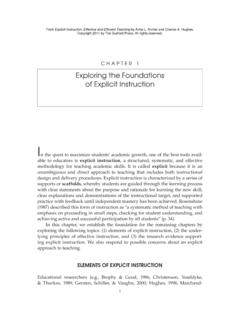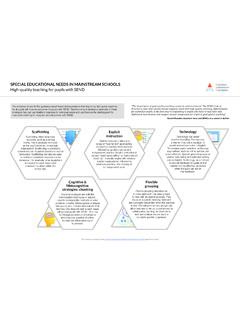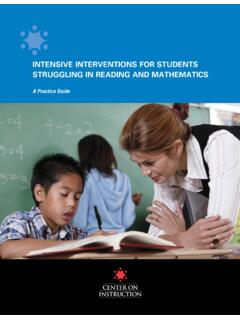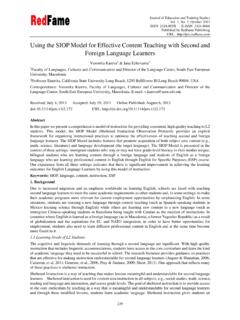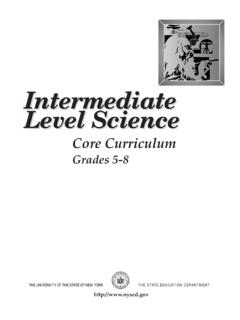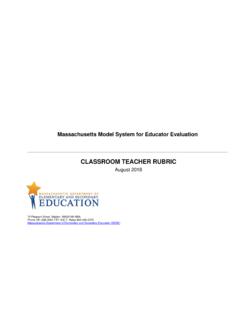Transcription of Building English Language Learners’ Academic Vocabulary
1 MULTICULTURAL EDUCATION24 Linguistically Diverse Students & Their FamiliesClaire Sibold is a professorin the School of Educationat Biola University,La Mirada, English Language Learners Academic VocabularyStrategies & TipsClaire Siboldand Zwiers (2008), ELLs require assistance in developing content-related Vocabulary in their second Language if they are to experi-ence success in school. Both native English speakers and ELLs need support in learning the Language that is used in the classroom as part of instruc-tion, reading, discussion, and assignments. Interweaving direct instruction in Academic Language helps students acquire an un-derstanding of abstract concepts, multiple meaning words, and content Vocabulary . When students are able to understand the Vocabulary for the that content they are reading and hearing, they will have a better understanding of the material. While wide reading promotes Vocabulary growth, ELLs who do not read enough cannot acquire the word wealth that would help them with Language Tier Model Beck, McKeown, and Kucan s (2002) Three Tier Model places Vocabulary words into three categories: Tier 1 which consists of basic or common words, Tier 2 which involves words that are used across the curriculum and multiple meaning words, and Tier 3 which is content specific vo-cabulary.
2 In this model (see Figure 1), Introduction According to Beck, McKeown, and Kucan s Three Tier Model (2002), when it comes to Language instruction the distinc-tion between Academic Vocabulary words and content specific words has a significant bearing on the Language success of English Language learners (ELLs). By using the strategies decribed in this article teachers and parents will have the means to develop ELLs Vocabulary through reading, direct instruction, and reinforcement activities and games. Teachers and parents can use these strategies before, during, and after reading, and thus provide students with a set of tools they can use independently as they read. Often Vocabulary instruction receives inadequate attention in elementary and secondary classrooms (Biemiller & Boote, 2006). Academic Vocabulary , specifically the Language that may occur in multiple contexts or the precise words that are presented in a specific context, can help students acquire new learning strategies and skills (Marzano, 2005).
3 Academic Vocabulary , however, is notably more difficult to learn than con-versational Language because it is more specific and sometimes abstract, making it difficult to grasp. Knowledge of this kind of technical Vocabulary in any specific con-tent area for example, social science, sci-ence, mathematics, or Language arts is directly linked to content knowledge. Stahl and Fairbanks (1986) found that such Vocabulary instruction directly im-proves students reading comprehension of textbook content. While the majority of teachers develop students Vocabulary across the curricu-lum, it is essential that English Language learners have explicit instruction about the Academic Vocabulary that is necessary for their success in Importance to ELLs When English Language learners struggle with reading comprehension, it can often be attributed to their difficulty with understanding the Vocabulary . Many studies report that low Academic Language skills are associated with low Academic performance (Baumann, Edwards, Font, Tereshinski, et al, 2002; Biemiller & Boote, 2006; Carlo, August, McLaughlin, Snow, et al, 2004).
4 These studies also report a discrepancy among students of diverse ethnicities related to the amount of Vocabulary they know and the depth to which they know and use that Vocabulary . According to Beck, McKeown, and Kucan, there are profound differences in Vocabulary knowledge among learners from different ability or socioeconomic (SES) groups (2002, p. 1). Thus, students with smaller vocabular-ies are at a greater disadvantage in learn-ing, and this lack of knowledge too often is the main barrier to their comprehension of texts and lectures (Newton, Padak, & Rasinski, 2008). According to Graves (2006) Figure 1 Graphic Organizer of Three Tier ModelThree Tier ModelTier 1:Basic Wordsu sight wordsu function wordsu words that name objectsTier 2:General Academic and Multiple Meaning Wordsu important to understanding textu words used across the curriculum u words with several meaningsTier 3:Specific Content Wordsu usage only in specific fieldu technical vocabularyu not part of everyday useWINTER 201125 Teaching Language LearningTier 1 words are the most common words in English and they make up a significant percentage of the words students read.
5 These words generally require little or no instruction, , table, swim, cars, and dog (Wosley, 2009). Sight words, function words, and words that name objects are included within Tier 1 Vocabulary . Tier 2 words are useful terms found with high frequency. These are words that are important to understanding the text and are used across the curriculum. For example, analyze, compare, and conclusion are words commonly used in Academic settings during instruction, in discussions, on tests, and in assignments. Multiple meaning words such as set, bat, base, and check have several meanings and must be presented in context in order to be understood. Students who are proficient in English typically have a better grasp of these words and are able to use them to communicate. Tier 3 Vocabulary words are found with less frequency and are typically lim-ited to specific content areas. According to Vacca and Vacca (2008) these words have usage and application only in a particular subject field, , centimeter, kilogram, and deciliter in a mathematics or science class, or abolitionist, emancipation, and secession in a history class (p.)
6 145). It is relatively easy for teachers to iden-tify these Tier 3 words in their textbooks. Stu-dents, on the other hand, struggle to define or explain the meaning of these Vocabulary words, words that are not part of the Language they use every day. Therefore, this technical Vocabulary needs to be taught explicitly and thoroughly (Vacca & Vacca, 2008).Effective Vocabulary Instruction Effective Vocabulary instruction em-phasizes direct instruction. For example, presenting both key words that help ELLs understand difficult text and multiple-meaning words that require students to use context to figure out the meaning will be necessary. By using direct instruction, teachers can incorporate relevant vocabu-lary into the before, during, and after read-ing stages of instruction (see Table 1). In order to help students remember new words, teachers can ask ELLS to as-sociate the new words with things that are already familiar to them, or the teacher can translate the words into the students primary Language (Colorado, 2007).
7 After students read, teachers can use word play to reinforce the understanding of new words and create enthusiasm for learning those new words. For example, Find the Ant-onym (divide g multiply) and Which One Doesn t Fit (square, circle, ruler, triangle) are two possibilities While students may learn new words by encountering them in their reading, it is critical that teachers give ELLs the tools for acquiring Vocabulary through explicit instructions . To create enthusi-asm for learning new words, teachers can help students hunt for clues that unlock the meaning of unknown words such as synonyms, descriptions, explanations, and visual aids. It is important to connect the new words to students prior knowledge. To do this, teachers can actively involve ELLs in learning new words, create a Vocabulary rich environment, and teach through a variety of strategies. For younger children, realia, actual objects or items, are useful for making abstract words more concrete.
8 For example, in teaching shapes, teachers can bring to the classroom objects of dif-ferent shapes. Real objects, pictures, and photographs that clearly match unfamiliar words pro-vide visuals that help ELLs make sense of the new words, , photographs of frogs and salamanders to illustrate amphib-ians. Teachers can also use anchor words for new words, , baseball cards as the anchor for collection, frogs for amphib-ians, and rice for grains. To create a rich Vocabulary environ-ment teachers can use a word wall that contains words from different content Table 1 Three Stages for Incorporating Relevant VocabularyBefore Reading:u Pronounce the word and use the Spanish equivalent; then have students repeat the word in English several timesu Tap students prior knowledge and identify anchor or familiar words for new Vocabulary words, , walk as the anchor for saunter u Pre-teach words before students read the materialu Introduce graphic organizers that show relationships among wordsu Show realia, actual objects, pictures, picture books, and video clips to introduce vocabularyu Use the Spanish equivalentu Teach students how to use the structure of words, , compound words, prefixes, roots, and suffixes, to break down a word into the meaningful unitsDuring Reading.
9 U Define words in context, using sentences from students reading materialu Help students find the context clues that will help them determine the meaning of an unknown word as they readu Use graphic organizers to help students process the contentu Show students how to use the dictionary to confirm their predictions about the meaning of the Vocabulary they meet in their readingu Talk-through the words as students hear these during oral readingu Use a variety of strategies to help students process the meaning of difficult wordsAfter Reading:u Focus on a limited number of key words, particularly interrelated words, to increase the depth of their understanding and concept developmentu Give students multiple exposures to words throughout the day in order to cement their understanding of the word meanings u Reinforce new words through activities, discussions, and assignments following students readingu Help make the words meaningful to students by linking the words with familiar things, people, or experiencesu Have students incorporate the new words into students writing assignmentsu Help students integrate new words into their speaking and writing vocabulariesu Display word walls and other graphic organizers with the new Vocabulary and definitions MULTICULTURAL EDUCATION26 Linguistically Diverse Students & Their Familiesareas, word books, and develop a reading room with books that teach and reinforce new concepts.
10 Word walls engage students visually and can be used to display content Vocabulary from the curriculum or involve students in activities that will help them learn new words. It is also helpful to in-tegrate the new Vocabulary into students writing for TeachingAcademic Vocabulary It is important to explicitly teach Vocabulary using effective strategies that will engage students in learning new words for example, association strate-gies, imagery, and graphic organizers. When introducing a new word, it is helpful to avoid a lexical definition as dictionary definitions often include other words that are equally difficult and do not make sense to the students. Instead, teachers can provide students with a description or explanation of the word or an example as shown in Figure 2. Repetition is one of the keys to learn-ing a new word. First, have the students listen to the pronunciation of the new word and at the same time view a picture or an actual object that goes with the word.










